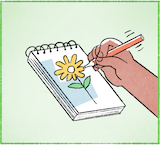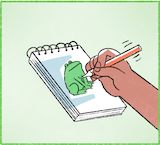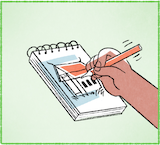


เขากำลังเฮ็ดหญัง กะมีคนคนหนึ่งเนาะ กำลังอาดสิวาด วาดพาบ วาดพาบหลือวาดลูบ อันนี้เบิ่งแล้วกะเป็นลูบดอกไม้
ลูบดอกไม้ดอกเดียวเนาะ มีง่าพ้อม มีใบสองใบ แล้วกะมีดอกพ้อม ดอกเดียวเด่ะ ดอกบานพ้อมเด่ะ บานสี เออ สีเหลียง
เขากะใซ้มือข้างเดียวเขาหละ มือข้างหนึ่งกะอาดสิจับอย่างอื่นเนาะ อาดสิจับสีไว้ แล้วกะใซ้มืออีกข้างหนึ่งละบายสี
แล้วลูบพาบนี้ หลือว่าดอกไม้นี้งามบ่ กะงามอยู่ เบิ่งงามๆ ดอก เขากะวาดงามอยู่เนาะ
12
เขากำลังเฮ็ดหญัง กะ เขากำลังวาดลูบเนาะ หลือว่าละบายสีลูบพาบ
อันนี้กะเป็นลูบกบเนาะ เบิ่งลักสะนะแล้วกะลูบกบ
กบโตสีเขียวพ้อมเด่ะ โตสีเขียว มีโตเดียวข้อหล้อ อยู่ในพาบ ในสะหมุดเหล้มนี้เนาะ อาดสิเป็นสะหมุดวาดพาบเนาะ เขากำลังวาดพาบ หลือว่าละบายสี
เพื่อที่สิให้ อาดสิเป็นเอาไว้ถ้าเด็กน้อยเบิ่ง หลือว่าอาดสิเป็นกานวาดพาบให้เจ้าของ เป็นเวลาว้างของเจ้าของเนาะ
13
เขากำลังเฮ็ดหญัง อันนี้เขากะกำลังวาดลูบ หลือว่าละบายสีลูบพาบอยู่เนาะ
มือหนึ่งกะจับสี กำลังละบายๆๆ สีอยู่ในสะหมุดวาดพาบเหล้มนี้เนาะ
แล้ว[เขา]กำลังวาดลูบอี่หยัง อันนี้เบิ่งลักสะนะท่าทาง หลือว่าเบิ่งซงแล้วอาดสิเป็นลูบวัดเนาะ
เป็นวัดเป็นโบดเนาะ อันบักใหญ่หนึ่ง โบดบักใหญ่งามซ้ำแมะ
Link to overview page
Link to dictionary
| Isaan | Pronunciation | Tones | Thai | English/Notes |
|---|---|---|---|---|
| เขา | khao | M | เขา | personal pronoun: he, she |
| กำลัง | gam-laŋ | M-HR | กำลัง | auxiliary indicating continuous or progressive action |
| เฮ็ด | het | H | ทำ | to do, to make |
| หญัง | ɲaŋ | M | อะไร, เป็นหญัง = ทำไม | 1. what {เขากำลังเฮ็ดหญัง = What is he doing?} {ธูปเอาไว้เฮ็ดหญัง = What are incense sticks for?} 2. something, anything, (nothing) 3. เป็นหญัง[...]คือ in initial position: why {เป็นหญังเขาคือใส่บักพิกลงไปในกวยเตียว = Why is he putting chili in [his] noodle soup?} {เป็นหญังหน้าต่างมันคือเปิด = Why is the window open?} {เป็นหญังมันคือมีควนไฟ = Why is there smoke?} |
| กะ | ga | M | ก็ | 1. then, consequently 2. also |
| มี | mi: | HR | มี | 1. to have 2. there is |
| คน | khon | HR | คน | person, people |
| หนึ่ง | nʉŋ | H | หนึ่ง | 1. one 2. after adjective: intensifier {บักคักหนึ่ง = very much} {อันบักใหญ่หนึ่ง = very large}, or attenuates the meaning {กะดาดมันแผ่นน้อยๆ หนึ่ง = the piece of paper is [relatively] small} |
| เนาะ | nɔ | H | เนาะ | final particle: makes the statement softer, looking for agreement |
| อาด | a:t | LF | อาจ | 1. might, may, will 2. likely |
| สิ | si | M | จะ | future tense auxiliary {เขากำลังสิตื่น = he's about to wake up} {สิไปตะหลาด = [I'm] going to the market} |
| วาด | wa:t | HF | วาด | to draw, to paint, to sketch |
| พาบ | pha:p | HF | ภาพ | 1. picture, photo 2. clf. for pictures, photos |
| หลือ | lʉ: | M | หรือ | or |
| ลูบ | lu:p | HF | รูป | 1. picture, image, photo 2. form, shape 3. clf. for pictures, images, photos |
| อัน | an | M | อัน | 1. thing, object 2. general clf. for objects |
| นี้ | ni: | HF | นี้ | 1. this 2. here |
| เบิ่ง | bəŋ | H | ดู | 1. to look at, to see, to watch {เบิ่งโทละทัด = to watch TV} {เบิ่งหนัง = to watch a movie} 2. to guess {เบิ่งซงแล้ว ... = [I] guess / from what it looks like ...} |
| แล้ว | lɛ:o | HF | แล้ว | 1. finished 2. already 3. and then, and next (especially แล้วกะ) 4. auxiliary for past tense |
| เป็น | pen | M | เป็น | 1. to be, to exist 2. to be able to 3. to suffer, sth. happens to 4. เป็นหญัง[...]คือ in initial position: why? {เป็นหญังเขากะคือแปงฟัน = Why is he brushing his teeth?} {เป็นหญังเคี่ยงบินมันคือสิตก = Why is the airplane falling down?} |
| ดอกไม้ | dɔ:k-mai | LF-HF | ดอกไม้ | flower |
| ดอก | dɔ:k | LF | ดอก | flower |
| เดียว | di:ao | M | เดียว | only, alone, single |
| ง่า | ŋa: | H | กิ่ง | 1. branch of a tree 2. stem of a flower |
| พ้อม | phɔ:m | HF | พร้อม | at the same time, also, too {มีตะเว็นพ้อม = the sun's out, too} {กะทะมีด้ามพ้อม = the pan has also a handle} |
| ใบ | bai | M | ใบ | 1. leaf {ต้นไม้มีใบสีเขียว = the tree has green leaves} 2. banknote {เทิงมีใบพ้อม เทิงมีเหลียนพ้อม = there are notes as well as coins} 3. clf. for leaves, bank notes, helmets, bowls, jars, pots, boxes {ใบบัว = lotus leaf} {ก่องใบน้อย = a small box} {หม้อใบนี้มีฝาพ้อม = the pot here has a lid, too} {ถ้วยใบสีแดง = a red bowl} |
| สอง | sɔ:ŋ | M | สอง | two |
| เด่ะ | de | H | น่ะ | particle used for emphasis |
| บาน | ba:n | M | บาน | to open, to bloom, to flower |
| สี | si: | M | สี | 1. color 2. colored pencil, crayon |
| เออ | ə: | M | 1. discourse marker: confirmation 2. discourse marker: turn-taking 3. discourse marker: preceding a correction 4. filler word |
|
| เหลียง | li:aŋ | M | เหลือง | yellow |
| ใซ้ | sai | HF | ใช้ | to use |
| มือ | mʉ: | HR | มือ | 1. hand 2. front leg/paw (e.g., of a cat) |
| ข้าง | kha:ŋ | LF | ข้าง | 1. side {มีหูจับสองข้าง = there are handles on both sides} 2. next to {วางอยู่ข้างๆ ก่องใบใหญ่ = it's placed next to the large box} {เขายืนอยู่ข้างๆ อีกพุหนึ่ง = he's standing next to another person} 3. clf. for body parts which come in pairs (eyes, ears, legs etc.) {เขามีตาสองข้าง = she has two eyes} |
| หละ | la | M | แหละ, ล่ะ | 1. auxiliary for emphasis at the end of a phrase 2. auxiliary to create a follow-up question: And what about ... ? {แล้วลดคันที่สองหละ = And what about the second car?} |
| จับ | jap | M | จับ | 1. to grasp, to hold {เขาจับมือกัน = they're holding hands} {เขายืนจับไอติมอยู่ = she's standing, holding an ice cream} 2. to catch, to arrest {จับพุล้าย = to arrest a criminal} |
| อย่าง | ya:ŋ | H | อย่าง | type, kind, sort, category |
| อื่น | ʉ:n | H | อื่น | other |
| ไว้ | wai | HF | ไว้ | 1. to keep, to put, to place, to retain, to save, to reserve {เขาเอาหัวของเขาไว้ใส = Where does she put her head?} {หมาสิเลี้ยงไว้บ้าน = dogs are kept/raised in the house} {ไก่เลี้ยงไว้ในคอก = chicken are kept/raised in a coop} {หน้ามันบังไว้ = the face is covered/not visible} {เขาเอาโทละสับวางไว้หู = he holds the phone to his ear} 2. for {นาลิกาปุกมีไว้เฮ็ดหญัง = What is an alarm clock for?} {หม้อเอาไว้เฮ็ดแนวกิน = a pot is used to make food} {ก่องเอาไว้เฮ็ดหญัง ก่องเอาไว้ใส่ของ = What is the box for? It's for putting in stuff.} Notes: see also ไว้ถ้า |
| อีก | i:k | LF | อีก | 1. more, again 2. other, another |
| ละบาย | la-ba:i | H-M | ระบาย | to paint, to colour |
| ลูบพาบ | lu:p-phap | HF-HF | รูปภาพ | picture, photo |
| ว่า | wa: | H | ว่า | 1. that, as {คำว่า X = the word X} 2. to say |
| งาม | ŋa:m | HR | สวย | beautiful, handsome, splendid |
| บ่ | bɔ: | H | ไม่ | 1. no, not 2. question particle, transforming a statement into a question Notes: spelling exception in line with common usage on social media |
| อยู่ | yu: | H | อยู่ | 1. to be (located) at 2. yet, still 3. auxiliary indicating continuous or progressive action {ทอดปาอยู่ในกะทะ = (in the process of) frying a fish in the pan} {แม่กำลังเมี้ยนเฮียนอยู่ = mother is cleaning/tidying up the house} |
| ดอก | dɔ:k | LF | หรอก, ดอก | 1. particle used after a negative, relativizing or explanatory statement to make the sense milder {กินเข้าบ่ บ่กินดอก = Are you going to eat [with us]? No.} {เป็นก้อนสี่เหลี่ยม ก้อนน้อยๆ ดอก = These are cubes, small cubes.} {แล้วกะมีลดคันหนึ่งขี่ผ่านมา เป็นลดเก็งดอก = And there's a car passing, a sedan.} 2. particle used to emphasize (not necessarily a negative) contrast 3. particle used for emphasis {ดอกไม้นี้งามบ่ กะงามอยู่ เบิ่งงามๆ ดอก = Is this flower beautiful? Yes, it's beautiful, it looks beautiful} |
| กบ | gop | M | กบ | frog |
| ลักสะนะ | lak-sa-na | H-M-H | ลักษณะ | feature, characteristic, quality |
| โต | to: | M | ตัว | 1. body, self 2. clf. for animals, characters/letters/consonants, appliances, clothes (e.g., pairs of trousers, shirts) |
| เขียว | khi:ao | M | เขียว | green |
| ข้อหล้อ | khɔ:-lɔ: | LF-LF | เท่านั้น, ขนาดนั้น, น้อยๆ | only {ต้นไม้มีต้นเดียว ต้นเดียวข้อหล้อ = there's one tree, only one tree} {มีบ้านหลังเดียวข้อหล้อ = there's only one house} |
| ใน | nai | HR | ใน | in, within |
| สะหมุด | sa-mut | M-M | สมุด | notebook |
| เหล้ม | lem | LF | เล่ม | clf. for books, notebooks |
| เพื่อที่ | phʉ:a-thi: | H-H | เพื่อที่ | in order to, so that Notes: the vowel เอือ is likely to be a Thai loan |
| ให้ | hai | LF | ให้ | 1. to give {หมอกำลังเอายาให้คนป่วยกิน = the doctor is giving the patient medicine} 2. for 3. to allow, to be allowed |
| เอา | ao | M | เอา | to take, to give {เขากำลังเอาก่องไปซั่ง = he's taking the boxes to weigh them} {หมอกำลังเอายาให้คนป่วยกิน = the doctor is giving medicine to the patient} {เอาไว้ถ้า = is for, is used for, has the purpose of} |
| ไว้ถ้า | wai-tha: | HF-LF | usually in a positive statement or answer: is for, is used for, has the purpose of {กะทะมีไว้ถ้าทอด = a pan is for frying} {น้ำบักนาวมีไว้ถ้าปุงอาหาน = lime juice is used to season food} {ปากกามีไว้ถ้าเขียน = a pen is for writing} {กะเทียมเอาไว้ถ้าเฮ็ดแนวกิน = garlic is used to make food} {ขาเอาไว้ถ้าญ่าง = legs are for walking} {เกิบเอาไว้ถ้าใส่ = shoes are for wearing} Notes: see also ไว้ |
|
| เด็กน้อย | dek-nɔ:i | M-HF | เด็ก, เด็กน้อย | child |
| กาน | ga:n | M | การ | prefix indicating the action of ... |
| เจ้าของ | jao-khɔ:ŋ | HF-M | เจ้าของ | 1. personal pronoun: oneself 2. owner |
| เวลา | we:-la: | HR-HR | เวลา | time, period |
| ว้าง | wa:ŋ | HF | ว่าง | empty {เวลาว้าง = leisure/idle time} |
| ของ | khɔ:ŋ | M | ของ | of, belonging to |
| อี่หยัง | i:-yaŋ | H-M | อะไร | 1. what {นี้คืออี่หยัง = What is this?} {มื้อนี้เจ้าเฮ็ดอี่หยัง = What are you doing today?} {กินเข้างายกับอี่หยัง = What did you have for breakfast?} 2. something, anything, (in negations) nothing {บ่ต้องเฮ็ดอี่หยังอีกเลยนอกจากใส่ปุย = [we] don't need to do anything besides adding fertilizer} |
| ท่าทาง | tha:-tha:ŋ | H-HR | ท่าทาง | 1. expression, look, manner 2. gesture 3. posture, appearance |
| ซง | soŋ | HR | ทรง | 1. shape, form 2. as if, like Notes: translation to be confirmed |
| วัด | wat | H | วัด | temple, Buddhist temple |
| โบด | bo:t | LF | โบสถ์ | Buddhist temple |
| บัก | bak | M | 1. intensifier before adjectives {ปาโตบักใหญ่ = a (very) large fish} 2. prefix in front of fruits and vegetables {บักแตงโม = watermelon} 3. can be used as a reference for a male person of the same or younger age {บักอันนี้ = this lad} |
|
| ใหญ่ | ɲai | H | ใหญ่ | large, big |
| ซ้ำแมะ | sam-mɛ | HF-H | (ด้วย)แหละ | final particle used for emphasis Notes: also pronounced ซ้ำแม |